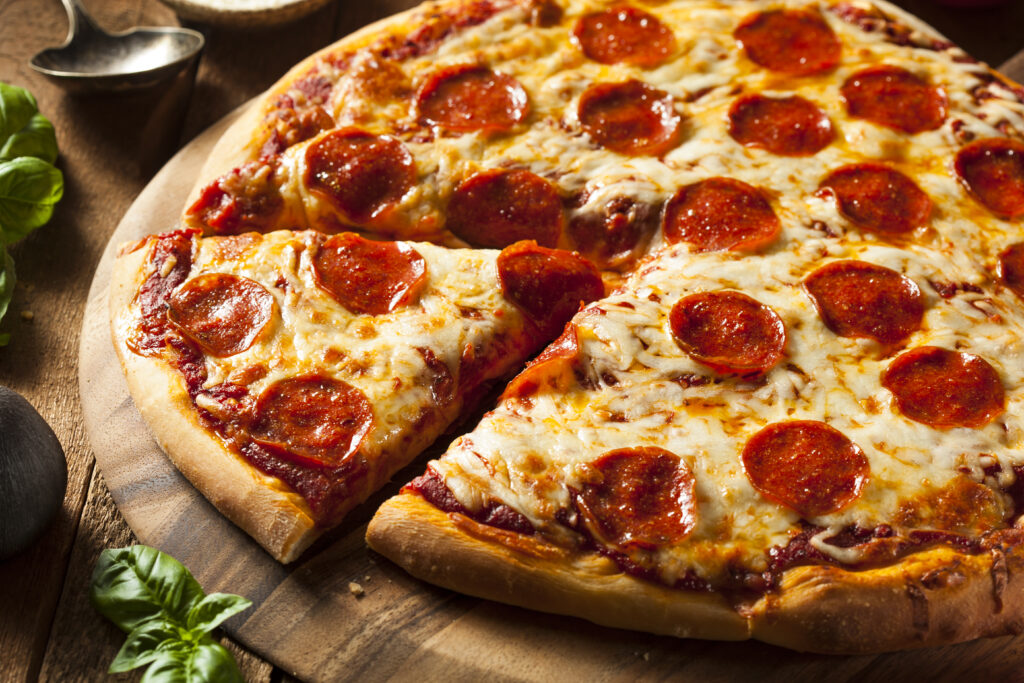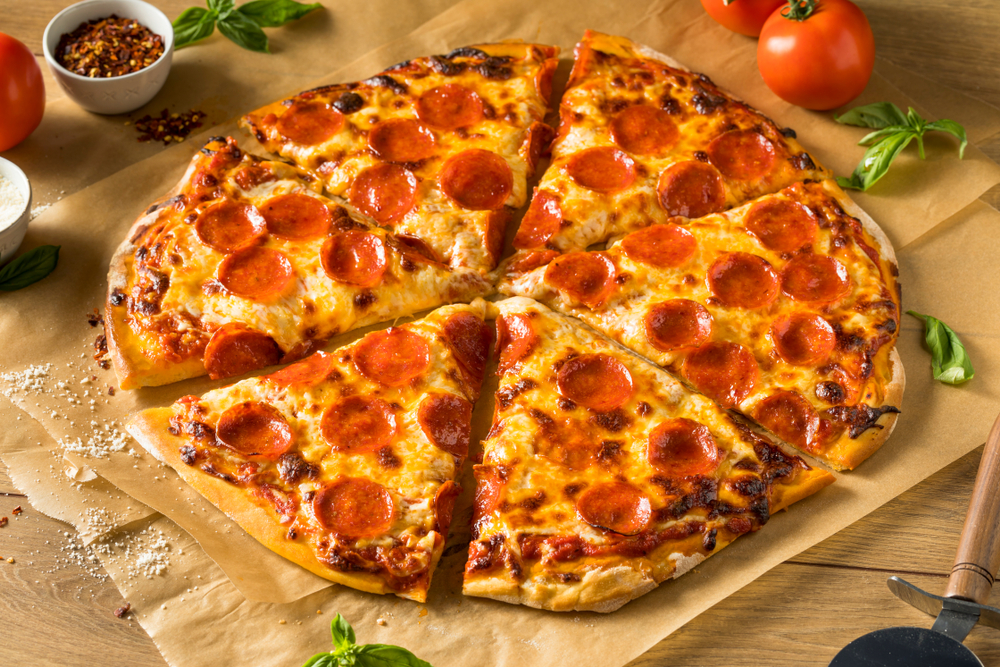One of the most consumed foods worldwide is pizza. It is a dinner that people of all ages can enjoy and is convenient, tasty, and economical. But as many are aware, there is one drawback to pizza: it may be greasy.

A typical issue that can taint an otherwise excellent lunch is greasy pizza. In this post, we’ll look at the reasons why pizza gets greasy and offer prevention advice.
There are several causes of greasy pizza. The cheese is one of the primary offenders. Cheese is a high-fat dairy product that when melted can release a lot of oil.
This oil may collect on the pizza’s top, resulting in a greasy mess. The toppings on the pizza might also result in greasy results.
When they are cooked, some toppings, like sausage and pepperoni, can also release a lot of oil. This oil may combine with the cheese to make the pizza even greasier.
If you enjoy pizza, you are aware of how disheartening it may be to bite into a greasy slice. It might make you feel heavy and uncomfortable in addition to being messy and unpleasant to eat. Luckily, there are precautions you can take to keep from eating oily pizza.
You can have a wonderful, filling pizza without all the grease if you choose the right toppings, cook your pizza correctly, and blot off extra oil. We’ll go into more depth about these suggestions in the sections that follow.
What Makes Pizza Greasy?
When it comes to pizza, we all love a good slice that’s hot, cheesy, and delicious. But sometimes, we take a bite and find that the pizza is just too greasy. So, what makes pizza greasy?

The Role of Cheese and Sauce
One of the main culprits of greasy pizza is the type of cheese used. Mozzarella cheese is the most popular cheese for pizza, and it is also the greasiest.
Other cheeses, such as cheddar or Parmesan, can also cause the pizza to be greasy. When cheese is melted, it releases a lot of fat, which makes the pizza greasy.
Another cause of pizza grease is the type of sauce used. Pizza sauce is usually made with tomatoes, which are naturally oily. When combined with other oils, such as olive oil or garlic, the pizza can become even more greasy.
The Impact of Dough and Crust
The pizza dough and crust can also play a role in making pizza greasy. If the dough is made with a lot of oil or butter, it can contribute to the overall greasiness of the pizza.
Additionally, if the crust is thin and crispy, it can’t absorb the excess oil and grease from the cheese and toppings, leading to a greasy pizza.
The Effect of Toppings
Toppings can also make a pizza greasy. Pepperoni, pork, sausage, bacon, and beef are all high in fat, which can contribute to the overall greasiness of the pizza. Additionally, watery toppings, such as mushrooms or olives, can release moisture during cooking, which can mix with the grease and make the pizza even more greasy.
To sum it up, pizza can become greasy due to a variety of factors, such as the type of cheese, sauce, dough, crust, and toppings used. By understanding these factors, we can make informed choices when ordering or making pizza to ensure that it’s not too greasy.
Baking Methods
When it comes to baking a pizza, there are several methods to choose from, each with its own advantages and disadvantages. In this section, we will discuss different baking methods, including oven types and temperatures, pan vs. stone baking, and precooking toppings.

Oven Types and Temperatures
The type of oven you use can have a significant impact on the quality of your pizza. Commercial pizza ovens are designed to cook pizzas quickly and evenly at high temperatures, typically between 700°F and 900°F.
Home ovens, on the other hand, are not designed specifically for pizza and may not get as hot as commercial pizza ovens.
To get the best results from a home oven, we recommend preheating your oven to the highest temperature possible, typically around 500°F. This will help ensure that your pizza cooks evenly and quickly.
Pan vs. Stone Baking
Another factor to consider when baking pizza is whether to use a pan or a pizza stone. A pizza stone is designed to absorb and distribute heat evenly, resulting in a crispy crust.
However, using a pizza stone can be tricky, as it requires preheating the stone and transferring the pizza to the stone without burning yourself.
Using a pan, on the other hand, is much simpler and can be done in any oven. A pan will also help keep your toppings in place and prevent them from sliding off the pizza. However, a pan may not result in as crispy a crust as a pizza stone.
Precooking Toppings
Precooking some of your pizza toppings can help reduce the amount of grease on your pizza. For example, if you are using sausage or bacon, you can cook it in a separate pan before adding it to your pizza. This will help remove some of the excess fat and prevent it from pooling on your pizza.
In addition to precooking toppings, you can also experiment with different cooking times and higher temperatures to reduce the amount of grease on your pizza.
By cooking your pizza quickly at a high temperature, you can help evaporate some of the excess moisture and prevent your pizza from becoming too greasy.
The key to baking a perfect pizza is to experiment with different methods and find the one that works best for you. Whether you prefer a crispy crust or a pan pizza with extra toppings, there are plenty of ways to achieve your desired result.
Reducing Grease
When it comes to pizza, a little grease is expected. However, too much grease can ruin the taste and texture of the pizza. In this section, we will discuss a few ways to reduce the amount of grease in your pizza.

Choosing the Right Cheese and Toppings
One way to reduce the grease in your pizza is to choose the right cheese and toppings. For example, mozzarella cheese is a good choice because it has a lower fat content than other cheeses.
Additionally, toppings like bacon, beef, and pork can increase the grease content of your pizza. Opting for vegetables or lean meats like chicken can help reduce the grease.
Thinner vs. Thicker Crusts
The thickness of the crust can also affect the amount of grease in your pizza. Thicker crusts tend to absorb more oil and fat, while thinner crusts are crispier and have less moisture content.
If you prefer a thinner crust, try using all-purpose flour instead of bread flour, and bake the pizza at a higher temperature to create a crispy crust.
Draining Excess Grease
Another way to reduce the grease in your pizza is to drain excess grease before serving. You can do this by placing the pizza on a paper towel or using a pizza screen to allow the excess grease to drain off. This will help make your pizza less greasy and more enjoyable.
Using Less Oil and Fat
Using less oil and fat in your pizza can also help reduce the grease content. Instead of using butter or oils, try using olive oil, which has less saturated fat. You can also try using less cheese or meat toppings, which will reduce the overall fat content of your pizza.
By following these tips, you can create a less greasy pizza that is still delicious and satisfying. Whether you prefer a thin crust or a Chicago-style deep dish, there are many ways to reduce the grease and enjoy a tasty pizza.
Where to Find Greasy Pizza
If you’re looking for a slice of greasy pizza, you’re in luck! We’ve scoured the internet and our own experiences to find the best places to get your fix.

Local Pizza Joints
One of the best places to find greasy pizza is at your local pizza joint. These places often have a loyal following of customers who swear by their greasy pies. Check out their hours of operation to make sure they’re open when you want to indulge.
Delivery Options
If you’re feeling lazy or just want to enjoy your greasy pizza from the comfort of your own home, delivery is a great option.
Many pizza places offer delivery services, so check to see if they deliver to your area. Keep in mind that delivery times may vary depending on the day of the week and time of day.
Store-Bought Pizza
If you’re in a rush or can’t make it to a pizza joint, store-bought pizza is a decent alternative. While it may not be as greasy as a freshly made pie, it can still satisfy your craving.
Look for frozen pizzas that are known for their greasiness, such as pan pizza or cheese pizza.
Best Days to Indulge
If you’re looking for the ultimate greasy pizza experience, we recommend indulging on Fridays, Saturdays, Tuesdays, Thursdays, or Sundays.
These are the days when pizza places are usually the busiest, meaning that the pies are more likely to be freshly made and extra greasy.
Whether you prefer your pizza greasy or not, there are plenty of options out there to satisfy your cravings. From local pizza joints to store-bought pies, you’re sure to find something that hits the spot.







Add comment